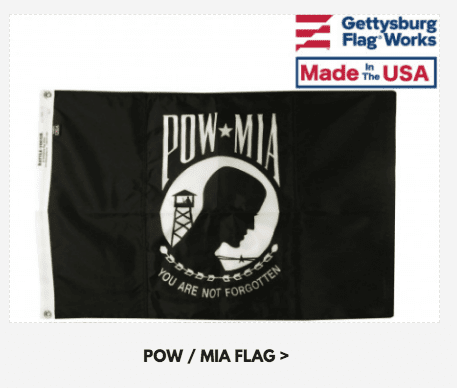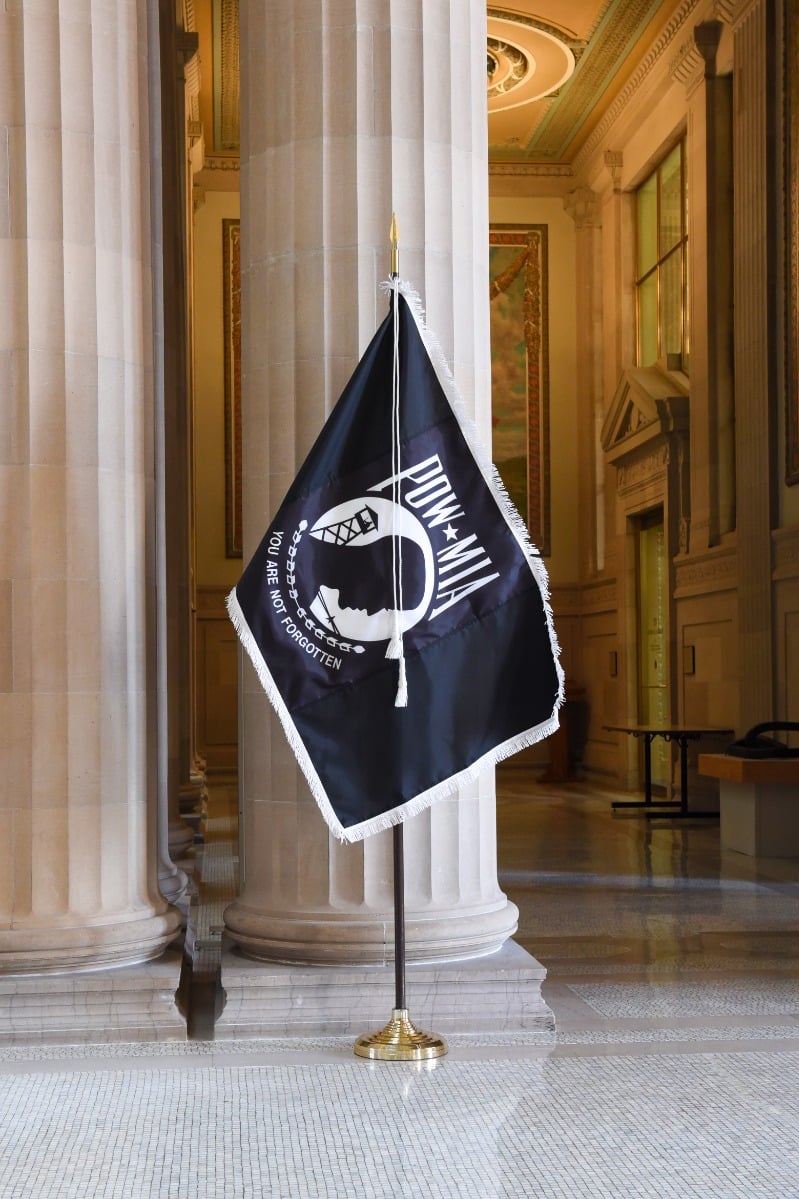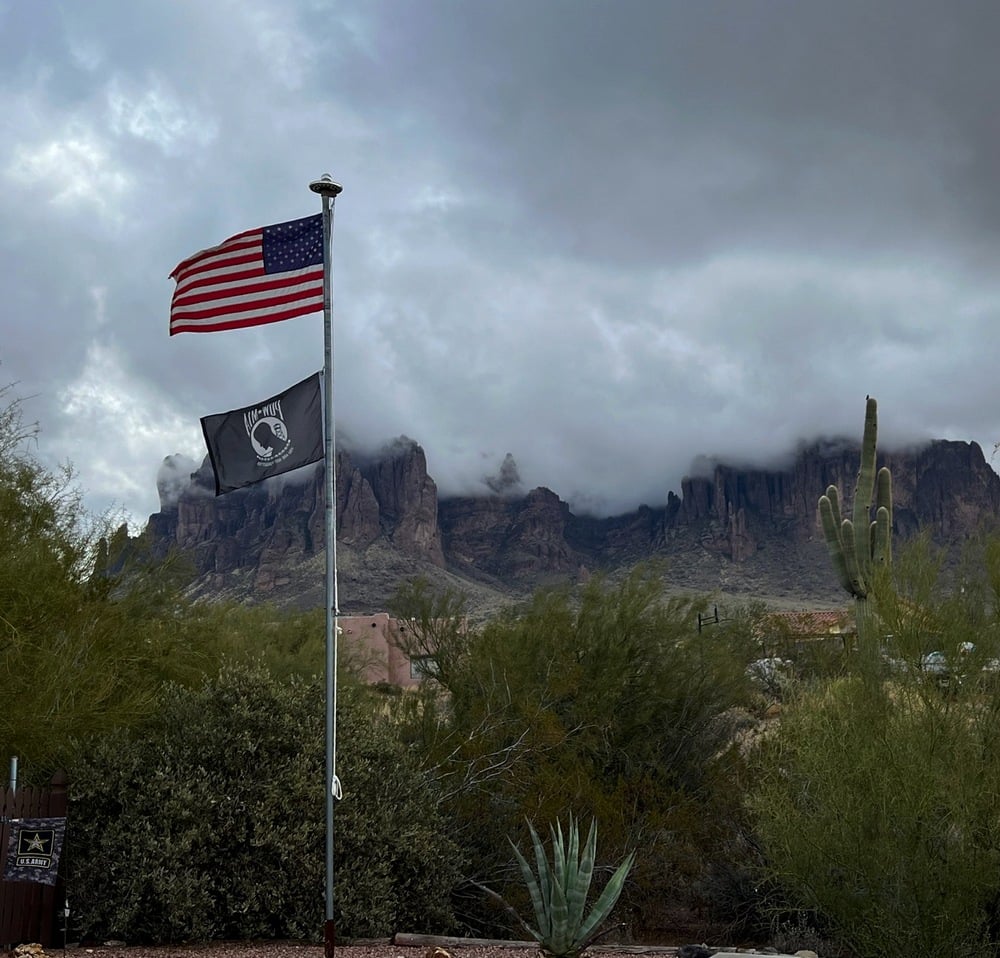POW/MIA Flag Etiquette

POW/MIA Flag Etiquette
Everything You Need To Know!

The black and white POW/MIA Flag features a silhouette of a prisoner of war, with a guard tower and barbed wire in the background, and the words “POW/MIA” at the top, and “You are Not Forgotten” beneath. Originally designated for American prisoners of war, missing in action or those otherwise unaccounted for in Southeast Asia, the flag is now widely accepted as a symbol of vigilance and remembrance for all POW and MIA.
To insure proper flag etiquette and respect for the POW/MIA flag, as well as other American Flags, the U.S. government has established flag codes, which detail how, when and where flags are to be displayed. The specific code for the POW/MIA flag is 36 U.S. Code, Section 902.
Take a look at why we fly our POW/MIA flag year round in the 30 second clip below and keep reading to learn all about the POW/MIA flag rules
When to Fly the POW/MIA Flag

Civilians are free to fly the POW/MIA flag whenever they wish, and it is commonly flown in front of police stations, fire stations and veterans’ organizations across the United States. However, on the national and federal level, there has been much debate over whether the flag should be displayed every day, or only on the six specific days noted in the 1998 Defense Authorization Act.
According to the 1998 Defense Authorization Act, Congress specified that the POW/MIA flag would fly each year on six national days of observance:
- Armed Forces Day — Third Saturday in May
- Memorial Day — Last Monday in May
- Flag Day — June 14
- Independence Day — July 4
- National POW/MIA Recognition Day — Third Friday in September
- Veterans Day — November 11
The law also specified where the POW/MIA flag would fly, and designated these locations:
- U.S. Capitol
- White House
- Korean War Veterans Memorial, Vietnam Veterans Memorial & the World War II Memorial
- All national cemeteries
- Buildings containing the Secretary of State, the Secretary of Defense, the Secretary of Veterans Affairs and the Director of the Selective Service System
- All major military installations, as designated by the Secretary of Defense
- All VA medical centers
- All U.S. post offices
The Federal Law was clarified in 2019, when President Donald J. Trump signed Public Law 116-67, amending the days on which the POW/MIA flag is displayed on federal property. Also known as the “National POW/MIA Flag Act”, the law amended Title 36 U.S. Code, Section 902 to state that the POW/MIA flag display days are “all days on which the flag of the United States is displayed.”
How to Fly the POW/MIA Flag

In order to insure proper respect for both the POW/MIA flag and the American flag, as well as any other banners, flag etiquette dictates the order in which flags should be displayed.
POW/MIA Flag with the American Flag on a Single Flagpole
When displayed on a single flagpole, the POW/MIA flag should fly directly below, and be the same size or smaller than, the U.S. flag. If a state or military flag is also flown, the POW/MIA flag should be flown above it, unless stated otherwise in the state flag code.
POW/MIA Flag with American Flag on Multiple Flagpoles
If the POW/MIA flag is flown with the American flag and other flags on adjacent flag poles, many believe that the POW/MIA flag should fly on the same pole and directly below the U.S. flag (if only 2 poles are available), or on its own pole directly to the U.S. flag’s left (the viewer’s right). State or military flags should be displayed on the second or third pole from the viewer’s right, unless stated otherwise in the state flag code. However, this is based on the Veterans of Foreign Wars (VFW) interpretation of the protocol, and is not technically part of the U.S. Flag Code.
More POW/MIA Flag Etiquette
Whenever the POW/MIA Flag, or any other flag, is displayed with our nation’s flag, it should always appear to the right of the American flag from the viewer’s perspective. In other words, the American flag should always be seen first when scanning from left to right.
For example, in a crossed staff display, the U.S. flag should be on the viewer’s left with its staff on top of the staff of the POW/MIA flag. Likewise, if both flags are flanking a speaker’s podium, the U.S. flag should be on the left side of the stage when viewed from the audience (the speaker’s right) and the POW/MIA flag on the opposite side. If marching with the POW/MIA flag and an American flag, the U.S. flag should be on the left and the POW/MIA flag on the right when the procession is viewed from the front.
Shop POW/MIA Flags
Gettysburg Flag Works carries a wide assortment of POW/MIA products, including POW/MIA Flags for Indoor Display, as well as Outdoor POW/MIA Flags and POW/MIA Garden Flags. We also offer POW/MIA Car Window Flags, POW/MIA Motorcycle Flags, Stick Flags, Grave Markers and POW/MIA Flag Lapel Pins.
For questions about any of our POW/MIA products, or to place an order by phone, give us a call at 1-888-697-3524.